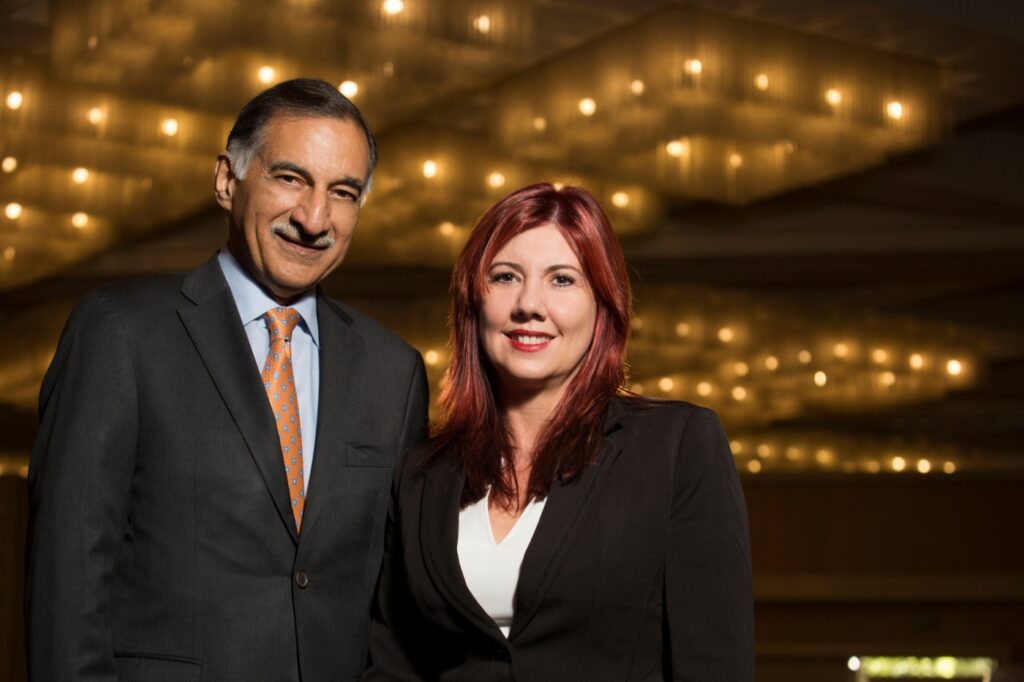
Rarely, said Cal State Fullerton economics professor Anil Puri, has there been such a confluence of significant events testing the fundamentals of how the country and the world works.
The summation of the past year was delivered during Puri’s opening remarks at the 2022 Spring Economic Forecast, held April 22 at CSUF’s Meng Hall.
Puri, director for the Woods Center for Economic Analysis and Forecasting at CSUF, and colleague and co-director Mira Farka shared their insight and economic prognostications in front of business leaders, fellow educators and students.
The two years of pandemic-induced upheaval seemed to be reversing itself in the fall.
The stock market rose, the unemployment rate dipped dramatically and consumer confidence spiked.
What happened since then?
Citing supply chain issues, skyrocketing prices at the pump, inflation, stagflation, Russia’s invasion of Ukraine and a worldwide pandemic, Puri said future generations will characterize the period as a “turning point.”
“A radical shifting of geopolitics because of the war going on, a realignment of financial intermediation … and a radical mixing of ideologies,” Puri said, “Not only in our country but throughout the world that is happening, combined with explosive growth in technologies and social media, all of this being pushed forward at a furious pace by the pandemic.”
Referring to the Russian invasion, “Ukrainians are paying the price with their blood,” Puri said, while the rest of the world has been impacted economically.
Puri spent the first 40 minutes of the forecast providing a disheartening list of economic indicators, nearly all pointing in the wrong direction.
Oil prices have soared considerably, almost 100% since the invasion started, with U.S. households paying $2,400 more per year at the pump compared with 2021.
Russia and Ukraine are exclusive suppliers of commodities such as neon, nickel, palladium and seed oil, and the disruption in trade created by the war has led to a 78 % spike in commodity prices.
Europe depends more heavily on Russia for commodities than the U.S. and, therefore, will be affected more dramatically as the war gets worse and more restrictions are imposed, Puri said.
The U.S. labor market is strong, however, with 540,000 jobs added per month for the past 18 months, he said.
The stock market is down since January but up significantly from where we were two years ago.
Manufacturing is strong but less robust than in 2021.
Supply and labor shortages are likely to continue along with sky-high inflation.
The Federal Reserve Bank is attempting to rein in spending, caused in part by stimulus spending, and more rate increases are likely, Puri said.
And the greatest area of uncertainty surrounds the war, the economist said.
“It’s sort of an open-ended war and we don’t know where it is going to head and it may lead to unexpected directions,” Puri said. “It is really an unknown risk.”
Moving forward, the journey is going to be a “treacherous” one and the road is going to be “winding,” he said.
Farka’s crystal ball didn’t reveal a rosy future either.
“I feel like there is no easy way, no sugar coating this,” Farka said. “Things are not shaping up as we had actually hoped. All the good stuff seems to be a little bit behind us. The reopening from the pandemic is over. No more fiscal support.”
The fiscal stimulus gave the U.S. a false sense of security, which Farka compared to “selling our souls to the devil.”
The economy recovered quickly but also aged quickly, she said.
Inflation is not just high, it is “sticky” she said, meaning the inflation spike is combined with stagnant growth.
“The most worrisome concern is where are we going to be 12-15 months from now,” Farka said. “Things are going to get a little heavy.”
We expect supply issues to get worse and worse and worse, especially during the summer,” Farka said.
The line of ships delivering supplies and anchored at the ports of Los Angeles and Long Beach delivering supplies will continue to grow.
But there is a modicum of good news, she said.
There is “oodles of cash” from the pandemic stimulus and money “sloshing around in the economy that should carry us about 12 months or so,” Farka said.
While pockets of the economy are not all the way back, they are improving, she said.
Segments of the hospitality sector are still in the red but should also trend in a positive direction.
In Orange County, unemployment is at 3.1%, down from a year ago.
The county is still recovering, with employment in the education, transportation and health care sectors seeing 5.4%, 3.6% and 1% increases, respectively, since February 2020.
Manufacturing and leisure and hospitality have improved in the county, but are still down 5.9% and 6.1%, respectively, from pre-pandemic levels.
Double-digit price appreciation has continued in OC’s housing market with the median price in the county reaching $1.167 million in February.
Expect a stabilization — but not reversal — of high prices, Puri said.
Quoting lyrics from the Scorpions’ “Wind of Change,” — which exulted in the fall of the Soviet Union, pointing to a more unified world — the winds of change of turned more ominous of late, Farka said.
“Let’s hope it won’t last for long,” she said.
Related Articles
Experience CSUF event gives future students a glimpse of college life
CSUF alum pays it forward through philanthropy, mentorship
Russia must account for its war crimes, experts say
Hard work, spirituality, familial support are keys to resiliency in APIDA community, experts say
Tennis is therapy for Ukrainian student far from home and family
